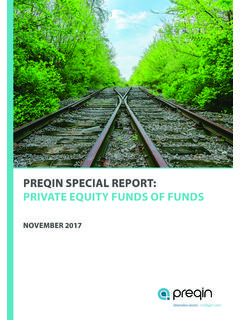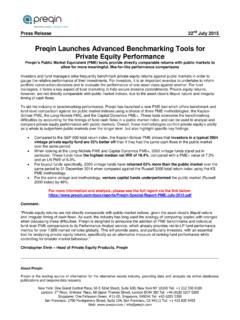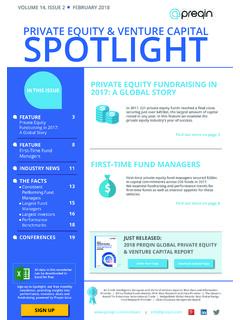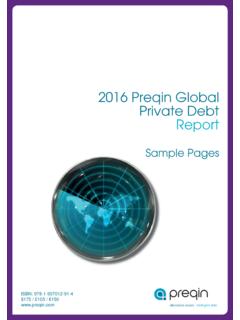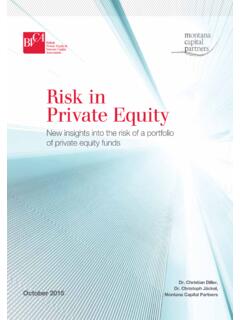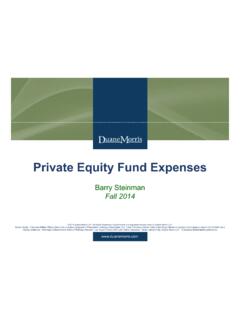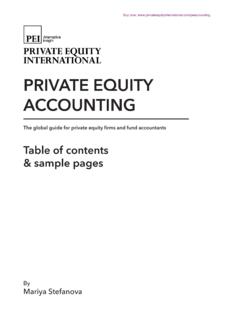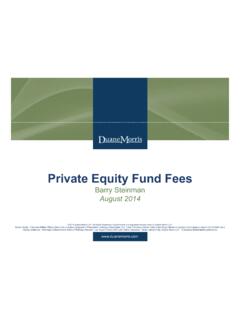Transcription of Measuring Private Equity Performance
1 Private Equity PerformanceVintage Year -The year of first draw down of capital for investment purposes, which generally coincides with the first year of a partnership's term. The year in which a Private Equity fund makes its first investment using LP Commitment - Investors in a Private Equity fund commit to investing a specified sum of money in the fund partnership over a specified period of time. This amount should exclude the GP contribution to the Calls/Draw Down - When a PE firm decides to make an investment, it will approach the LPs in order to draw down their money. This is the actual act of transferring the committed capital. This amount should include management up (%) = 100 Capital Distribution These are the returns that an investor in a Private Equity fund receives. It is the income and capital realised from investments less expenses and liabilities. Once a limited partner has had their cost of investment returned, further distributions are actual profit.
2 This amount should exclude any carry/ Performance fees earned by the (%) = 100 Fair Value/Market Value A valuation that represents the amount at which an asset could be acquired or sold in a transaction between willing parties. Also referred to as Ending Market Value, Net Asset Value or Residual Value. This amount should exclude any carry/ Performance fees earned by the GP and include a provision of carry for unrealized (%) = 100 Multiple (X) reveals how many times investors have, or are likely to get their money back and make a profit from their investments. It is the sum of the Residual value of the portfolio plus distributed capital. Multiple (X) = { Distribution (%) + Value (%) } Internal rate of return (IRR) = This is the most appropriate Performance benchmark for Private Equity investments. In simple terms, it is a time-weighted return expressed as a percentage. IRR uses the present sum of cash contributed, the present value of distributions and the current value of unrealised investments and applies a discount.
3 This amount should exclude any carry/ Performance fees earned by the GP and include a provision of carry for unrealized : measure of the cumulative LP capital invested relative to the total capital committed by the LPsDistribution to Paid-In (DPI): measure of the cumulative investment returned to the investor relative to invested Value to Paid-In (RVPI): measure of how much of the investors capital is still tied up in the Equity of the : Performance Ratios - Fund ExampleExample:The following example simulates how to calculate the Performance ratio for a fund with the following characteristics:Total LP Commitment= USD 10,000,000 Total Capital Called to Date = USD 1,455,000 Total Distribution to Date = USD 750,000 Unrealised fair value = USD 1,190,000As of Date: 30-Jun-2009 Explaining the Called-Up Ratio:Called-up (%): is a measure of the cumulative capital invested (including management fees) relative to the total capital committedCalled up (%) = 100 The called-up ratio in this example would be calculated as follows:Total capital called to date including management fees = 1,455,000 Fund Size = 10,000,000 Called-up (%) = 1,455,000 10,000,000 100 Called-up (%) = the Distribution to Paid-In (DPI %) Ratio:Distribution to Paid-In (DPI %): measure of the cumulative investment returned to the investor relative to invested (%) = 100 The distribution to paid-in ratio in this example would be calculated as follows:Total Distributions to Date = 750,000 Total Capital Called = 1,455,000 Distribution to Paid-In (DPI %) = 750,000 1,455,000 100 Distribution to Paid-In (DPI %) = the Remaining Value to Paid-In (RVPI %) Ratio:Remaining Value to Paid-In (RVPI %).
4 Measure of how much of the investors capital is still tied up in the Equity of the : Portfolio valuations should be carried out in accordance with IFRS; GAAP; FAS 157 and/or International Private Equity and Venture Capital (IPEVC) Value to Paid-In (RVPI %) = 100 Then the remaining value to paid-in ratio in this example would be calculated as follows:Unrealised fair value = 1,190,000 Total Capital Called = 1,455,000 Remaining Value to Paid-In (RVPI %) = 1,190,000 1,455,000 100 Remaining Value to Paid-In (RVPI %) = the IRR (Internal Rate of Return):Internal rate of return (IRR): This is the most appropriate Performance benchmark for Private Equity investments. IRR uses the present sum of cash contributed, the present value of distributions and the current value of unrealised investments and applies a discount. Assuming that the transactions for this fund were as following - the net IRR can be calculated on Excelusing the cash flow data.
5 Transaction TypeTransaction Date Transaction AmountCapital Call14-Jan-06100,000- Capital Call25-Jan-06105,000- Capital Call16-Feb-06100,000- Capital Call17-Jan-06175,000- Management Fees31-Mar-0610,000- Capital Call16-Apr-06100,000- Capital Call25-Jun-06105,000- Capital Call16-Sep-06100,000- Capital Call25-Nov-06175,000- Management Fees31-Dec-0610,000- Capital Call16-Apr-07100,000- Capital Call20-Sep-07100,000- Distribution15-Nov-07250,000 Management Fees31/12/200710,000- Capital Call25/06/2008105,000- Distribution01/07/2008300,000 Capital Call20/09/200850,000- Management Fees31/12/200810,000- Capital Call19/01/2009100,000- Distribution16/05/2009200,000 Unrealised Fair Value30/06/20091,190,000 Net : Formula in Excel = XIRR(values, date)Capital Calls: negative sign; All Management Fees: negative sign; Distribution: positive sign; Unrealised Fair Value: positive of Vintage Year:The year of the first draw down of LP capital for investment purposes, which generally coincides with the first year of a partnership's term.
6 Alternatively, the year in which the Private Equity fund makes its first Overview:Using the ratios as calculated above the Performance ratios for this fund will be as following:Fund NameVintage TypeTotal LP Commitment (Mn) Called (%) Dist. (%) (DPI) Rem. Value (%) (RVPI) Net IRR (%) As-of DateSample Fund2006 Venture 10 30-Jun-09

